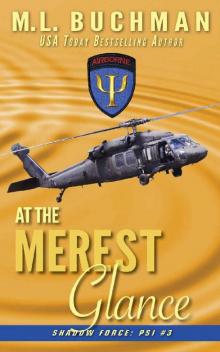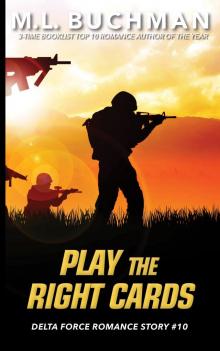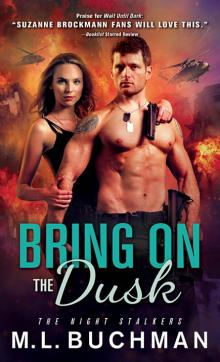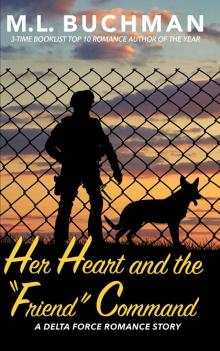- Home
- M. L. Buchman
Condor Page 2
Condor Read online
Page 2
1 hour ago
(11 p.m. Central Standard Time)
Dmitri Voskov lined up with the approach vector into Fort Campbell and daydreamed of what wonders awaited him in Kentucky.
The load of Russian helicopters would go to the 160th Special Operations Aviation Regiment. SOAR was the US Army’s secret helicopter regiment and no concern of his.
Kentucky though…
It wasn’t the land of petite Scandinavian white-blondes, but he’d been in the American South enough to appreciate the seriously built gold-blondes as well—even when it was dyed.
No one would match the Helsinki Airport security officer who wore nothing under her uniform. That would be asking too much. But she’d left him with plenty to dream about. She’d also left him a phone number and first name—Valery. Valery, a female name in the West and a male name in Russia; it fit her strength well. She had the finest body he’d been invited to plunder since a fiery Irish redhead on a layover in Shannon, Ireland, three years before.
While finishing the tie-downs and double checks, Portnov had lowered the cockpit stairway and Dmitri had given Valery a tour upstairs.
Bunks near the back of the compartment—just ahead of the wings. Enough for the two loadmasters and the four-man flight crew to live in comfortably. The Antonov was their home most days of the year. A small lounge, bathroom, and a decent kitchen.
They’d tiptoed through as the rest of his flight crew were snoring away in their bunks. Normally, he’d be ticked that they’d been so comfortable while he’d been trapped outside, but he had just spent a very, very friendly hour steaming up a car’s windows with an exceptionally flexible officer.
In the cockpit, he gave her the full tour and grabbed a couple of nice feels. He’d spent most of the evening wishing Portnov would hurry up. Standing in the cockpit with Valery, he wished the man would screw up and ground them here for a week.
“May I use bathing room?”
“You know the way. Don’t worry about waking the other guys; you could drop a nuclear bomb and they would sleep through it.”
On her return, Valery had asked in that charming mangled-English of hers as she closed the cockpit door, “Does these doors lock?”
He’d reached across her, latched it, and tried to take her right up against the surface.
Instead, she’d guided him to the pilot’s chair. Sliding it to the back of the stops, there was just room for her to straddle him once she stripped.
Over Valery’s bare shoulder and out the windshield, he’d caught Portnov looking up in surprise from the ground four stories below, then grinning.
Plenty to grin about here.
The only thing more amazing than her hair, face, and breasts had been what she could do with her hips.
She would start a motion somewhere deep inside that built in a slow gyration to—
The radio hauled him back to the present. “Antonov, this is Campbell Army Airfield. You’re cleared to land Runway 23. Winds light and variable. Barometer two-niner-niner-five.”
“Roger, Tower. I have the ILS.” Everything looked good.
Everything.
Including the updated schedule from the home office that said they’d be back in Helsinki in just three weeks. The first moment he was on the ground, he’d text Valery with the good news.
He rode the big plane down the glide slope into the darkness. They’d flown west all night—a rough ride north of the Azores, but nothing unusual. Here in Kentucky, it was still before sunrise under crystal clear skies.
Dmitri barely needed the Instrument Landing System; the runway was properly lit and clear despite the busy American Army base wrapped around it.
Fort Campbell had plenty of runway, but he still placed the main gear on the pavement in the first five hundred feet. Nose gear down at a thousand.
It would be good to get out of the cockpit and stretch. He might not even go barhopping. Maybe he’d just hit his bunk, think about Valery, and count the days until they were back in Finland.
When Captain Dmitri Voskov pulled back to engage the thrust reversers on the four brand-new GE CF-6 engines, a hidden microswitch was engaged.
It had been placed by SVR Zaslon Major Elayne Kasprak as Dmitri had buried his face in her breasts—so skilled with his tongue that she’d almost missed the proper placement.
But the switch was in the correct location and was now pressed by the control lever.
The switch turned on a tiny transmitter that sent a signal to a receiver she’d placed fifty feet behind the cockpit. Elayne Kasprak had hidden it beneath the rearmost bunk while ducking out of the cockpit to supposedly use the bathroom.
The receiver was attached to a detonator.
The detonator had been rammed into the heart of a shaped charge of C-4 explosive. The device—called a Krakatoa and originally designed for the British SAS, which she’d picked up from a UK munitions plant to avoid it being traced back to her—was no bigger than a fat beer can. That had made it easy to hide in her security officer’s parka coat.
The two kilos of C-4 plastique exploded.
The copper bullet formed by the device could punch a double-fist-sized hole through a warship’s armor plate at twenty-five meters.
At two meters, it punched a half-meter-wide hole through the crew cabin’s thin rear pressure wall and the central wing fuel tank close behind it.
As a by-blow, it also turned the bottom of Loadmaster Portnov’s bunk into a thousand pieces of shrapnel. His body was shredded—along with the Playboy Polska magazine he’d picked up in Warsaw last week, and had been using as a visual aid while he imagined Dmitri’s blonde going down on him.
The sound had been muffled by the sleeping room door—now blown off its hinges—and the closed cockpit security door. In the cockpit, twenty meters forward, it was no louder than a blown tire on the main gear.
“Shit!” Dmitri checked the indicators, but no red warning lights. Hopefully not a brake fire or a broken wheel axle. Please let it just be the rubber. An Antonov was a rare enough bird that they carried their own spares, but they couldn’t carry everything. With twenty main gear tires and four nose gear ones, and two stashed in the hold, he could lose one with few worries.
The central wing tank had been run mostly dry during flight. Now it was filled with a shallow pool of Jet A fuel and nitrogen that had been pumped in as the tank emptied to decrease the chance of fire.
The blast of the Krakatoa not only heated the remaining fuel above the ignition point, but the hole it created allowed oxygen to rush into the breached tank. A small windstorm sucked various detritus into the breached tank.
Four seconds after the initial detonation, their speed was down to a hundred knots. The massive plane wasn’t pulling to either side, so Dmitri decided the problem might not be too terrible; probably just a flat tire rather than a frozen axle.
Two thousand feet of runway gone, eight thousand still clear ahead. Under normal operations, the Antonov would need only a thousand more feet before turning off onto a taxiway—for all their size, helicopters didn’t weigh much, less than a third of the Condor’s load capability though they had filled every square meter of deck space.
At five seconds, a fireball followed the stream of oxygen and flashed back through the original penetration in the tank and the cabin’s rear bulkhead. Portnov’s bunk had collapsed to partially block the hole. The blockage only lasted a few hundredths of a second against the monstrous pressure wave.
It ignited the entire crew cabin and killed the other loadmaster, filling his lungs with fire when he breathed in to scream.
Other than a sudden inward bulging of the closed cockpit door, the active flight crew, including Captain Dmitri Voskov, remained unaware of what was happening behind them. The copilot had opened his small side window to smell the fresh Kentucky air—splendidly warm and lush in the mid-March night—so their ears didn’t even pop at the sudden overpressure.
Seven seconds after the initial blast, the mounting e
xplosion’s pressure wave inside the fuel tank exceeded critical rupture.
Both of the central tanks’ side seams failed at a hundred and thirty-seven percent of design maximum.
Steel shrapnel from the shredded central tank blew through the wing tanks to either side, spilling the three thousand remaining gallons of reserve Jet A fuel into the wing structure. From there, it cascaded down onto the runway through mechanical openings for flaps and landing gear.
At nine seconds past ignition of the Krakatoa, both wings exploded internally. Bits of fuel tank and wing covering were blown so high that the last of them didn’t return to the ground until well after the rest of the plane was destroyed.
The flash lit the darkness. The emergency response teams, woken by the blast, were on the move before the control tower could even sound the alarm.
If the wings had broken free, the fuselage might have survived.
Still marginally attached, they kept spilling fuel and feeding the fire along either side of the plane, turning the fuselage into a furnace that was still being cooked from the inside by the burning of the fuel dumped from the central tank over the helicopters in the cargo bay.
Captain Dmitri Voskov’s final act fully damned the aircraft.
He stood hard on the brakes for an emergency stop.
They worked. All twenty-four wheels locked hard, leaving ten-meter stripes of black rubber on the runway that would be visible for years.
The Antonov AN-124-200 Condor squatted in the middle of its own inferno and burned.
Directly below the cockpit and crew area, the armament on the Mil Mi-28NM Havoc helicopter heated past critical.
An Ataka-V anti-tank missile was the first to go. The blast ignited the three other missiles in the rack as well as the five smaller weapons in the S-13 rocket pod. These in turn triggered the Product 305 air-to-air missile that the West was very eager to inspect for the first time.
The navigator and flight engineer died instantly from the impact of the multi-headed explosion against the bottom of the crew section. No one heard the copilot’s scream. Instinct had him reaching for escape through his small side window when the force of the explosion severed his arm against the sill.
The combined blast was sufficient to separate the already weakened connection between the crew section and the wing assemblies. As the sides of the hull blew outward, the cockpit and living quarters were blown upward as a unit.
Because its attachment at the nose held longer than at the wing, the rear end of the twenty-meter-long assembly arced skyward, trying to fly one last time before breaking free and landing on its back ahead of the fire.
The inverted cockpit assembly now lay on Runway 23 at Fort Campbell, Kentucky, clear of the shattered fuselage and its raging heat.
Its escape from the fire didn’t matter.
The final slam of the cockpit section onto the runway had killed the last survivor.
It snapped pilot Dmitri Voskov’s neck as neatly as if Major Elayne Kasprak had done it herself.
She always got her man.
1
Spieden Island, Washington
10 p.m. Pacific Standard Time
Now
* * *
Miranda’s phone interrupted her attempt to make the others say, “Ewan McGregor.”
It was Charades, but she didn’t know who Ewan McGregor was.
When she’d asked Holly for help—it was guys versus girls—she’d whispered “Star Wars” as if that explained anything.
“Timer’s still running,” Mike called out as she stopped to answer the call.
Good. Maybe it would run out before she was done with the call. No, Mike was tipping the tiny hourglass onto its side to stop the running sand. It was only fair.
“Hello?”
“Where’s your team?”
Miranda had always appreciated that General Drake Nason didn’t waste his time on unnecessary niceties.
“Holly’s on the couch, Mike is in my mother’s armchair,”—Mike looked down at his seat as if that was somehow shocking—“and Jeremy’s sitting on the floor by the coffee table.”
Drake’s soft laugh made no sense. “Okay. Where are all of you?”
“At my house.”
“Where is that, Miranda?”
Oh. “I live on Spieden Island in the San Juan Islands of Washington State, United Sta—”
“Yes, I know that Washington State is in the US.”
“—States. Okay, well that’s where we are.”
“How fast can you get to Kentucky?”
She didn’t need to ask why. There was a major military airplane crash or he wouldn’t have called.
In fact, though they’d met many times, it was only the second time that the Chairman of the Joint Chiefs of Staff had called her. The first, the CIA had been using a SWAT team to try and capture her during a crash investigation. She hoped that it would be less traumatic this time.
“We’ve had wine. Except for Holly, who’s had beer. But she’s not a pilot anyway, so I suppose that isn’t of direct consequence. Neither Mike nor I can legally fly for another eight hours. So, we can be aloft at six a.m. My Sabrejet can make the crossing in three hours and the Mooney in twice that.”
“I assume there’s a runway on your island. I’ll get a C-21 headed in your direction.”
“It could land, but it couldn’t take off again. My runway is eleven hundred feet too short for a Learjet’s minimum takeoff roll.” Its required forty-seven hundred feet was almost half the length of her entire island from rocky cliff to rocky cliff.
There was a long pause before he came back. “What’s the side-to-side clearance?”
“Two hundred feet.”
“Good.” Another, briefer pause. “I’ll have a Hercules C-130 out of Joint Base Lewis McChord there in twenty minutes.”
“I wouldn’t advise tha—”
“Just get ready.” The Chairman of the Joint Chiefs of Staff knew that Miranda hated unfinished sentences.
“I wouldn’t advise that. No sane pilot would land a C-130 in the dark at a grass strip airport with only thirty-five feet of clearance off either wing.”
“We have the best combat pilots in the world, Miranda. Be ready.”
And he was gone.
“They’re going to send a C-130 Hercules to land on Spieden Island?” Mike was frowning. As the team’s other pilot, he would understand the implications.
“That’s so cool!” Jeremy sprang to his feet and rushed off to gather his gear.
Only as they were driving the golf cart through the chill drizzle from the house to the hangar did Miranda remember the problem.
“The deer!” The sharp pine smell of the Douglas fir trees made her think of them curled up cozily in the field grass, already growing lush despite the cold spring.
“The deer?”
“The island has a herd of deer. They’ve been sleeping on the northwest end of the runway lately.”
“No worries.” Holly dropped the three of them at the hangar to gather the rest of the gear. She always drove when they were together—which seemed to irritate Mike Munroe every time.
Perhaps that was why she insisted?
Miranda was never very sure on what made people do things.
Then Holly raced off into the night beeping the cart’s little horn as she went.
Good thinking.
Only as Holly was returning from the far end and the sound of four Allison T56 turboprop engines roared by close overhead did Miranda remember to turn on the runway lights.
Not quite such good thinking.
2
“I swear to God, I thought they were messin’ with me, ma’am, when you turned on those lights. Telling me to land here? Look at me, I’m still shaking.” The pilot said as they ascended the plane’s rear cargo ramp.
He held out his left hand with the fingers spread wide and shook it like a leaf.
Then he raised a rock-steady right hand, “Thank God this is my flying hand.�
��
“I thought it took two hands to fly a C-130?”
“I’m so good I only need one.” He winked at her for some unfathomable reason.
Miranda tried to understand how someone could control both the wheel and the throttles simultaneously with only one hand.
Before she could ask, Holly had tugged her away from the pilot and led her up the ramp.
“What’s with the yellow hats, you all on the same team?” he called out after them.
“Yes,” Holly called back over her shoulder.
“No,” Miranda stopped. “Well, we are, but the hats aren’t relevant to that. The Matildas are the Australian women’s national soccer team and—”
Holly towed her out of earshot as the pilot turned to Mike and repeated his line about how he’d made the landing one-handed.
If he was untrustworthy in his speech, was he also untrustworthy as a pilot?
Miranda considered the landing to have been good work, but turning around a plane with a hundred and thirty-two-foot wingspan between massive Douglas firs only two-hundred feet apart had been even more impressive to watch. The C-130 did have a published turning ability within a hundred and eighty feet; she’d just never seen it demonstrated before.
Her own jet had a wingspan of a mere thirty-seven feet and still it felt cramped to make a full turn. The Hercules transport was by far the largest plane to ever land on Spieden Island. It was a pity that it was so dark, it would have been nice to have a picture of that.
For now, she would trust the pilot of the Hercules, if not the man who was the pilot.
She sighed.
That particular incongruity was going to bother her for a long while.
Inside, the Hercules transport’s cargo bay was nine feet high, ten wide, and long enough to carry three Humvees. The four of them and their packs took up very little of the space.
As soon as they were aloft, Holly scrounged up some blankets and ear plugs from the loadmasters. “Get shut-eye while you can.”
It was good advice. Miranda had stayed up far past her bedtime to play a game she didn’t understand.

 White Top
White Top Thunderbolt
Thunderbolt Storm's Gift
Storm's Gift The Complete Delta Force Shooters
The Complete Delta Force Shooters At the Quietest Word (Shadowforce: Psi Book 2)
At the Quietest Word (Shadowforce: Psi Book 2) At the Slightest Sound
At the Slightest Sound Dilya's Christmas Challenge
Dilya's Christmas Challenge Raider
Raider Havoc
Havoc Carrying the Heart's Load
Carrying the Heart's Load Flying Beyond the Bar
Flying Beyond the Bar Firelights of Christmas
Firelights of Christmas Where Dreams Are Well Done
Where Dreams Are Well Done Nathan's Big Sky
Nathan's Big Sky Heart of a Russian Bear Dog
Heart of a Russian Bear Dog Drone: an NTSB / military technothriller (Miranda Chase Book 1)
Drone: an NTSB / military technothriller (Miranda Chase Book 1) Flower of Destiny
Flower of Destiny Drone
Drone Ghostrider: an NTSB-military technothriller (Miranda Chase Book 4)
Ghostrider: an NTSB-military technothriller (Miranda Chase Book 4) Wild Fire
Wild Fire Team Black Sheep
Team Black Sheep The Complete Delta Force Warriors
The Complete Delta Force Warriors At the Quietest Word
At the Quietest Word At the Merest Glance
At the Merest Glance Havoc: a political technothriller (Miranda Chase Book 7)
Havoc: a political technothriller (Miranda Chase Book 7) White Top: a political technothriller (Miranda Chase Book 8)
White Top: a political technothriller (Miranda Chase Book 8) Between Shadow and Soul
Between Shadow and Soul Island Christmas
Island Christmas Survive Until the Final Scene
Survive Until the Final Scene Midnight Trust
Midnight Trust Return to Eagle Cove
Return to Eagle Cove Where Dreams Reside
Where Dreams Reside Honor Flight
Honor Flight Where Dreams Are Sewn
Where Dreams Are Sewn The Complete Hotshots
The Complete Hotshots Condor
Condor I Own the Dawn
I Own the Dawn Chinook
Chinook At the Merest Glance: a military paranormal romance (Shadowforce: Psi Book 3)
At the Merest Glance: a military paranormal romance (Shadowforce: Psi Book 3) Since the First Day
Since the First Day Thunderbolt: an NTSB / military technothriller (Miranda Chase Book 2)
Thunderbolt: an NTSB / military technothriller (Miranda Chase Book 2) For Her Dark Eyes Only
For Her Dark Eyes Only Play the Right Cards
Play the Right Cards Lost Love Found in Eagle Cove
Lost Love Found in Eagle Cove Big Sky Ever After: a Montana Romance Duet
Big Sky Ever After: a Montana Romance Duet Keepsake for Eagle Cove
Keepsake for Eagle Cove At the Clearest Sensation
At the Clearest Sensation The Ides of Matt 2015
The Ides of Matt 2015 When They Just Know
When They Just Know Cave Rescue Courtship
Cave Rescue Courtship Wildfire at Dawn
Wildfire at Dawn Dawn Flight
Dawn Flight Blaze Atop Swallow Hill Lookout
Blaze Atop Swallow Hill Lookout The Sword of Io
The Sword of Io Christmas at Steel Beach
Christmas at Steel Beach Heart's Refuge
Heart's Refuge By Break of Day (The Night Stalkers)
By Break of Day (The Night Stalkers) Kee's Wedding
Kee's Wedding Just Shy of a Dream
Just Shy of a Dream Path of Love
Path of Love Ghost of Willow's Past
Ghost of Willow's Past Flash of Fire
Flash of Fire Target of the Heart
Target of the Heart Sound of Her Warrior Heart
Sound of Her Warrior Heart Target of Mine: The Night Stalkers 5E (Titan World Book 2)
Target of Mine: The Night Stalkers 5E (Titan World Book 2) The Complete Where Dreams
The Complete Where Dreams Target of One's Own
Target of One's Own For All Their Days
For All Their Days Pure Heat
Pure Heat Love's Second Chance
Love's Second Chance Target Engaged
Target Engaged Bring On the Dusk
Bring On the Dusk Wait Until Dark (The Night Stalkers)
Wait Until Dark (The Night Stalkers) Big Sky, Loyal Heart
Big Sky, Loyal Heart Welcome at Henderson's Ranch
Welcome at Henderson's Ranch Damien's Christmas
Damien's Christmas Flight to Fight
Flight to Fight Nara
Nara Looking for the Fire
Looking for the Fire Love Behind the Lines
Love Behind the Lines Peter's Christmas
Peter's Christmas In the Weeds
In the Weeds Christmas at Henderson's Ranch
Christmas at Henderson's Ranch They'd Most Certainly Be Flying
They'd Most Certainly Be Flying Fire at Gray Wolf Lookout (Firehawks Book 8)
Fire at Gray Wolf Lookout (Firehawks Book 8) Wildfire on the Skagit (Firehawks Book 9)
Wildfire on the Skagit (Firehawks Book 9) A Hotshot Christmas
A Hotshot Christmas Off the Leash
Off the Leash Where Dreams Books 1-3
Where Dreams Books 1-3 Guardian of the Heart
Guardian of the Heart The Ides of Matt 2017
The Ides of Matt 2017 Where Dreams Unfold
Where Dreams Unfold Twice the Heat
Twice the Heat Wild Justice (Delta Force Book 3)
Wild Justice (Delta Force Book 3) Flying Over the Waves
Flying Over the Waves Love in the Drop Zone
Love in the Drop Zone I Own the Dawn: The Night Stalkers
I Own the Dawn: The Night Stalkers What the Heart Holds Safe (Delta Force Book 4)
What the Heart Holds Safe (Delta Force Book 4) The Christmas Lights Objective
The Christmas Lights Objective Road to the Fire's Heart
Road to the Fire's Heart Night Rescue
Night Rescue Delta Mission: Operation Rudolph
Delta Mission: Operation Rudolph Full Blaze
Full Blaze Night Is Mine
Night Is Mine Lightning Strike to the Heart
Lightning Strike to the Heart Beale's Hawk Down
Beale's Hawk Down Circle 'Round
Circle 'Round Cookbook from Hell Reheated
Cookbook from Hell Reheated Zachary's Christmas
Zachary's Christmas Reaching Out at Henderson's Ranch
Reaching Out at Henderson's Ranch Fire Light Fire Bright
Fire Light Fire Bright The Ides of Matt 2016
The Ides of Matt 2016 Her Heart and the Friend Command
Her Heart and the Friend Command On Your Mark
On Your Mark Swap Out!
Swap Out! Heart of the Cotswolds: England
Heart of the Cotswolds: England The Phoenix Agency_The Sum Is Greater
The Phoenix Agency_The Sum Is Greater Wildfire at Larch Creek
Wildfire at Larch Creek Target Lock On Love
Target Lock On Love Second Chance Rescue
Second Chance Rescue Where Dreams Are Written
Where Dreams Are Written First Day, Every Day
First Day, Every Day Christmas at Peleliu Cove
Christmas at Peleliu Cove Heart Strike
Heart Strike Man the Guns, My Mate
Man the Guns, My Mate Emily's Wedding
Emily's Wedding Daniel's Christmas
Daniel's Christmas Frank's Independence Day
Frank's Independence Day The Phoenix Agency: The Sum Is Greater (Kindle Worlds Novella)
The Phoenix Agency: The Sum Is Greater (Kindle Worlds Novella) Roy's Independence Day
Roy's Independence Day